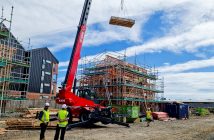
Geoffrey Meikle outlines the reasons why a hazardous substances audit is necessary and the steps that should be taken to minimise risk and meet required standards.
Since 1 July 2004 the safe management of approved hazardous substances has been regulated under seven main lifecycle regulations such as disposal, emergency management and packaging, plus another eight other regulations covering such things as bulk storage tanks, compressed gases and fireworks.
The responsibility to ensure that this safe management is adhered to is laid on the person in charge. In order to help the person in charge implement best practices to comply with all of these regulations the HSNO Act promotes and encourages places of work to follow codes of practice.
Storing, supplying and using hazardous substances poses risks to people and the environment right through the life cycle chain of the substance, and since risk in its simplest form is the product of the consequences of an incident times its likelihood of happening the more we can reduce each of these variables the lower the risk will be.
All well and good for the person in charge. However, at a place of work the person in charge’s primary role is to ensure maximum productivity and profit for the enterprise. As long as the sodium cyanide is doing its job in the electroplating bath or the anhydrous ammonia is doing its job in the chillers, the priority to check that their storage, handling and disposal complies with all of the aspects of the appropriate regulations comes a second best in many person in charge’s day-to-day activities.
In fact this is analogous to running a vehicle. As long as it starts, provides a degree of comfort to the driver and completes its journey, the safety of it being on the road would be not a terribly high priority to the owner if it were not for a regular legally required audit by way of a warrant of fitness.
A ‘warrant of fitness’ or site audit for a place of work managing hazardous substances also provides the same degree of assurance that a place of work is minimising the risks of managing the hazardous substances.
It should also be conducted six monthly or at least annually, and will result in a report that identifies which systems are working to minimise risk and those which are not.
What are the benefits and costs of getting an independent site audit? The answer to this question can only come from assessing the consequences and likelihood of having an incident with the hazardous substances being managed on the site.
The benefits are not only an assurance that the site is legally compliant but also an assurance that the risks arising from the human factor are also as low as can be reasonably be expected.
Two significantly costly and inconvenient incidents that occurred quite separately in March 2014 neatly illustrate this. The first involved a 200 litre drum of hydrochloric acid and the second just 2.5 litre of the same substance in a glass bottle. In the first case a significant suburban area of Auckland was evacuated with the assistance of Police and travel was disrupted for six hours. In the second case in Wellington two employees were taken to hospital for observation and the business operation was terminated for most of the day.
Both incidents caused essentially the same degree of risks to people and similar orders of cost from emergency services, even though the amount of the same hazardous chemical in one incident was only one percent of that in the other incident.
They no doubt occurred because safe handling systems and/or staff training were either not in place or not followed. A HSNO audit would have highlighted the potential for both sets of incidents to occur and made recommendations to minimise the risks of their occurring.
What does an audit entail?
Firstly, the auditor needs to have a good understanding of the properties of the hazardous substances and the legislation governing their use and management. It is likely that he or she will be a WorkSafe New Zealand-approved Test Certifier. Secondly, they need to have the maturity and experience to develop a good empathy with the person in charge.
The stage will be set to cover both of these at an introductory meeting to discuss the aims and objectives of the enterprise and its ‘culture’. After all, the outcome of the audit should be a report that enhances the profitability and integrity of the business and not an indictment of it. Following the site management meeting the auditor will review the organisation’s written systems and procedures and assess whether they meet the regulatory requirements.
The audit starts with the hazardous substance inventory, which should have the classification for the hazardous substance and the maximum quantity of each the site expects to have at any one point. These will allow the auditor to know exactly what substances the site deals with, what to expect to see on site, and what kind of compliance documentation is required.
HSNO classifications come from the Safety Data Sheets (SDS) which accompany a site’s hazardous substance inventory. If any SDS is missing critical information such as the HSNO classifications, New Zealand distributor/manufacturer contact information, a New Zealand 24-hour emergency number, or the HSNO approval code, then the SDS is not compliant and must be updated – the same applies if the SDS is more than five years old. The supplier of the hazardous substance will be able to supply these when requested.
If the site deals with enough hazardous substances to warrant them, the auditor will want to look at the sites certification for locations, stationary tanks, and Approved Handlers, along with electrical compliance dossiers for any equipment installed within a hazardous atmosphere zone.
Operating procedures for the site covering hazardous substance storage, use, identification, emergency management, and disposal, along with all relevant staff induction and training records, will be checked for suitability and extent of detail.
A site may have spill procedures or an emergency response plan written up, but if they’re not tested and reviewed annually then they will be of little benefit when an actual event occurs and staff can’t remember how to respond appropriately.
All sites should have a site plan, whether a CAD drawing or aerial shot of the site, which outlines the locations of hazardous substances and hazardous atmosphere zones (if any). It’s also recommended to include storm drains, elevations, and nearby fire hydrants (if appropriate), as a copy of the site plan should be given to the local fire department and knowing more about the lay of the land gives emergency services a better idea of how to respond.
The auditor should look next at the site’s general health and safety procedures to assess risk analysis processes, if health monitoring of workers is required (based on the hazardous substances present), records of health monitoring and occupational medical histories, and to gain an overall understanding of the workplace’s health and safety culture.
After the documentation has been reviewed, the auditor will want to take a look around the site itself and not just where the hazardous substances are stored or being used. The construction of the building and dangerous goods (DG) stores, the security of the site, where the substances are stored, and the suitability of protective equipment will all be scrutinised.
Appropriate identification
Even if the site doesn’t use enough hazardous substances to warrant full HAZCHEM signage at the gate or on the outside of the building, the place where substances are stored should still be appropriately identified – such as flammable solvent cabinets or DG stores.
The auditor may interview personnel on their knowledge around HSNO or site procedures, either at random or for those in high-risk areas, or ask to see how equipment such as PPE, spill kits, or emergency equipment (if available) is used.
Finally, the auditor will hold an exit meeting with the person in charge and any other key personnel to give them an overview of the audit’s findings and to discuss any urgent actions that may need to be taken.
This should be followed with a written report that spells out in a brief and simple manner those aspects of the operations that are to be complimented and those where deficiencies were noted and how to correct them. A good audit report will also note observations from the auditor’s experience on other areas of the operation that would benefit by implementing suggested changes.
Once the non-compliances have been fixed or implemented, the auditor will often supply a certificate of compliance recognition – this in no way replaces an actual compliance certificate but serves to show that the site has been assessed by a third party.
Geoffrey Meikle is Managing Director of Technical Compliance Consultants (NZ) Ltd, HSNO consultants and EPA Test Certifiers providing training, consultancy, certification and regulatory advice to industry using hazardous substances




